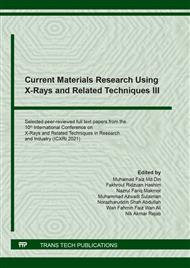p.626
p.633
p.639
p.645
p.651
p.658
p.664
p.672
p.678
Phase Transformation of FGD By-Product into Plaster Mould via Heat Treatment Process
Abstract:
Flue Gas Desulfurization (FGD) is a waste incineration process commonly used to eliminate sulfur dioxide (SO2) from flue gas power plants. FGD by-product recorded a rich gypsum content, also known as calcium sulfate dehydrate (CaSO4•2H2O), which has promising practical applications in plaster mould production. Plaster of Paris (POP) with a chemical composition of calcium sulfate hemihydrate (CaSO4•0.5H2O) is widely used in plaster mould production because of its quick setting and hardening upon moistened. Naturally, gypsum with 2 molecules of crystalline water can change to 1.5 molecules via the dehydration process. Various dehydration methods were conducted to transform FGD gypsum to hemihydrate. After undergoing different autoclave processes, the phase transition of FGD by-products was identified by X-ray diffraction (XRD) mode and compared with commercial POP. Chemical composition of FGD sludge contains a high amount of calcium oxide (CaO), sulfur trioxide (SO3) and boron trioxide (B2O3), as well as other impurities such as fluorine (F), chlorine (Cl), and magnesium oxide (MgO). Based on phase analysis, sample H1 to H5 show the percentage of hemihdyrate is 1.5%, 19.7%, 2.8%, 1.2%, and 46.1%, respectively, after different dehydration methods.
Info:
Periodical:
Pages:
672-677
Citation:
Online since:
January 2022
Price:
Сopyright:
© 2022 Trans Tech Publications Ltd. All Rights Reserved
Share:
Citation:


